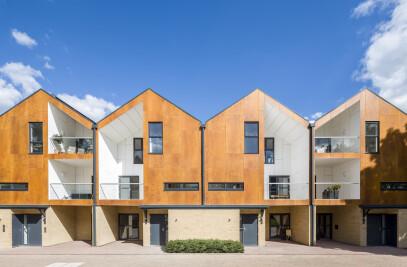Sustainable community garden learning centre empowers disadvantaged locals through education
Entrepreneurial charity, Good Food Matters, has created a community Food Learning Centre in New Addington, Croydon. The Centre teaches disadvantaged local people to grow, cook and market sustainably produced organic food. It provides them with a new set of skills, promotes a healthy lifestyle and helps them to be productive members of their community.
Geraghty Taylor Architects has designed the Community Hub Teaching Kitchen and associated garden where people are taught the skills and confidence they need to reintegrate into society. The key drivers of the project’s design were Inclusivity and Sustainability, values that are also deeply embedded in Geraghty Taylor’s own philosophy. Inclusive design To ensure that all areas of the centre are accessible to disabled people, Good Food Matters and Geraghty Taylor Architects have worked closely with the Croydon Disability Forum. Many of the decisions regarding the centre’s design were governed by the need to create a truly inclusive scheme. Adjustable worktops have been installed inside the centre along with specialist fittings and clear circulation routes which help facilitate disabled users. Outside grasscrete paving has been used widely throughout the site to allow disabled users access whilst also minimising rainwater run-off. Special raised growing beds ensure that disabled people can be a part of growing and maintaining the food they produce.
Brenda Puech, NRAC Consultant on behalf of the Centre for Accessible Environments, commented: “The design presents a clear and well organised gardening site and teaching building that has incorporated inclusive design principles.” Sustainability The new building incorporates a number of sustainable features such as solar thermal panes for heating water and solar PV panels which have been fitted in order to reduce the schemes reliance on electricity supplies. The centre’s roof is clad in a standing seam metal sheet system that allows rainwater harvesting, and tall windows ensure that the building is largely naturally ventilated and lit, enabling getter environmental performance. Low-volume-flush WCs and aerated taps also help save on water. The building’s extensive glazed main entrance lobby minimises space heating losses through needless air-changes thereby reducing the need for energy consuming space heating. An extremely well insulated building ‘fabric’ consisting of a timber clad, closed panel timber frame structure has further reduced the need for heating. The building is cooled in summer through tall openable windows designed to draw cool fresh air via covered external spaces.
The teaching building has been sensitively designed to fit into its greenbelt context. The building draws on the tradition of simple ‘working’ buildings that punctuate the English countryside.
The centre’s garden comprises growing beds, orchards, beehives, greenhouses and a wildlife meadow that not only provides the food for the teaching sessions at the centre, but also generates a vigorous, bio-diverse landscape, which is open to all.

































